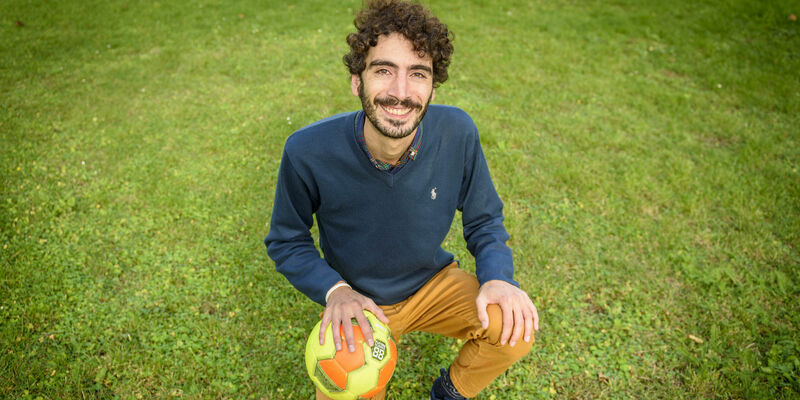
- Home Stretch , Sports , Research
- 24/09/2020
Home Stretch | Miraculous Messi
Messi isn’t just the world’s greatest soccer player in all probability, but certainly also the most special player in all the major European leagues. That is the conclusion of Gabriel Manfredi based on data of several hundreds of soccer matches, which he used to express both player performance and playing style in figures. The Argentinian researcher recently gained his Master’s degree at Human-Technology Interaction.
Gabriel Manfredi is a real soccer fan: he recently even watched all the games, via internet, from the legendary 1986 World Cup – when Diego Maradona almost single handedly delivered his nation the world title. “Each one of Maradona’s ball contacts during that tournament was simply amazing,” Manfredi says enthusiastically.
Soccer analysists would probably have concurred that Maradona deserved high grades for those matches, but judging player performance is quite a subjective affair, generally speaking. That was the reason why Manfredi, who specialized in data science during his Master’s Human-Technology Interaction, wanted to investigate to what extent algorithms are better at identifying the best player on the pitch.
Automatically
“Some websites already grade all the players after each match, completely based on ‘event data’ from the match,” Manfredi explains. “That’s done fully automatically, but how that algorithm works exactly is a painstakingly guarded secret.” He got the opportunity to delve deeper into this for his graduation project when he was provided access, via an Italian scientist, to a dataset of 1826 matches from the French, German, English, Spanish and Italian leagues of the 2017-2018 season. “That dataset contains all player actions during matches, such as passes, runs, header duels, etcetera.”
Before he started, Manfredi expected that the computer would be able to judge players more fairly, because it operates more objectively. “Now I’m not so certain about that anymore. It even turns out that the computer puts greater emphasis on goals and assists than human analysists do, because the algorithm learns, via ‘machine learning,’ which actions are decisive for the final outcome.” He doesn’t dare to say who makes the better analysis, humans or computers. “There’s no objective criterion for that. What is clear though, is that there is more disagreement among human analysists than among the algorithms I’ve looked at.”
Playing style
There’s much more information about players to be gained from ‘event data’ from soccer matches than just the performances per game. That is why Manfredi, together with his supervisor Chris Snijders, decided to conduct a follow-up research after his graduation project, during which he investigated whether you can recognize soccer players individually based on their stored actions. In other words: does a player have an individual playing style that can be recognized with an algorithm? That would be a great outcome, Manfredi believes, for soccer scouts, who could have the computer make a preselection when they are looking for a certain type of player.
The result is a model with eighty parameters that describes the playing style of each player in the data set - approximately fifteen hundred in total. “We weren’t the first ones with this idea,” Manfredi admits. “We’ve combined a few ideas from two earlier studies and added things to these. Player’s runs and how they pass and receive the ball to and from their team mates are important features. We decided not to take the quality of a player into account in the model.”
Messi
Obviously, such a model for playing style needs to be consistent at the very least. The researchers checked this by randomly dividing all the matches into two groups, after which they ran a separate analysis on both groups of matches. “You would expect that the player who most resembles a certain player from one group of matches, is the very same player, only calculated for the other half of the matches. That turns out to true be in sixty percent of all cases in our model, a significantly better result than our predecessors achieved.”
When asked which player deviates most from the others in terms of playing style, Manfredi gives a surprising answer: “That turns out to be Messi, even though we didn’t look at quality at all. The fact that he has a particularly free role and therefore moves around the pitch in a different way than other players might have something to do with that, but we too found the result very interesting.”
Compare players
Those who are interested can visit a special site, made by Manfredi, where they themselves can compare players. Perhaps they’ll come across a copy of Ronaldo, or a Zlatan clone who can still be bought for almost nothing. It would be great if commercial parties were to show an interest, Manfredi says. “Data analysis in soccer has been quite booming these last few years, but I’m afraid that clubs are mostly cutting their costs at the moment due to the corona crisis.”
Discussion